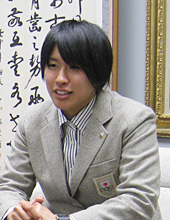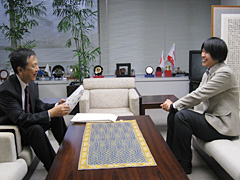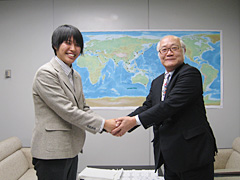Top>Hakumon CHUO [2010 Spring Issue]>First Winter Olympics Female Athlete in the History of Chuo University: Miss Konomi Asazu, Women's 2-Rider Bobsled
 Index
Index
Topics
First Winter Olympics Female Athlete in the History of Chuo University: Miss Konomi Asazu, Women's 2-Rider Bobsled
Miss Konomi Asazu
2010 Alumni of the Faculty of Letters
16th place, but satisfied with a personal best.
Focusing on the Sochi Olympics in 4 years.

Miss Konomi Asazu
“I want to win a global event. I want to become an athlete who can compete at the international level.”—After a slight hesitation, Miss Konomi Asazu gave this answer in reply to a question regarding her impression of the Olympics. Just a few months ago, Miss Asazu had stated that her goal was simply to participate in the Olympics. However, she now has her sights set on a much higher goal. “I will focus on giving my best performance at the Sochi Winter Olympics (Russia) which will be held in 4 years,” proclaimed Miss Asazu.
Miss Asazu (who will graduate from the Faculty of Letters this spring) represented Japan in the women's 2-rider bobsled event held at the Vancouver Winter Olympics (February 12th to 28th). Her participation as a female student in the winter Olympics was another historic first for Chuo University, which is celebrating its 125th anniversary.
Miss Asazu gave her best effort and finished in 16th place. However, she faced stiff competition from the world's best athletes. “I am satisfied that I posted a personal record time. However, I am still a long way from being a top level competitor,” says Miss Asazu as she fixes her sights on the world.
Two athletes are involved in the 2-rider bobled. The pilot is responsible for turning the steering wheel and the breaker is in charge of the sprint at the start of the race. The two riders work together in an effort to post the fastest time possible. Miss Asazu is a breaker, and she teamed with the veteran pilot Manami Hino.
The bobsled course at the Vancouver Olympics utilized a track of ice totaling 1,300 meters in length. Competitors raced down the course at speeds of up to 150 kph, completing the course in approximately 53 seconds. The course is one of the most difficult in the world and there were many crashes during the competition.
Bobsledding is known as F-1 on ice. The same speed which makes the event so appealing also makes it dangerous.
The role of the breaker is to push the bobsled and sprint for a distance of 25 meters from the start line. After that, the breaker jumps into the sled. The initial speed of the bobsled is measured at a distance of 50 meters from the start line. Miss Asazu's best time is 5.50 seconds, while a time of 5.30 is at the world's top level. Although this is a difference of a mere 0.20 seconds, it can lead to a difference of several seconds by the time the bobsled reaches the finish line. Therefore, the starting sprint is a key to successfully competing.
First participated in training camp in August of last year.
Makes use of athletic ability displayed in the heptathlon.
Miss Asazu's special event is the women's track and field heptathlon (100 meter hurdles, 200 meter race, 800 meter race, high jump, long jump, shot put and javelin). She is a top athlete in university women's track and field, and won her event at the Inter-University Athletic Union of Japan Track and Field Championships in September two years ago and finished second during last year's event. Because of her outstanding athletic ability, she came to the attention of the Japan Bobsleigh and Luge Federation, which was searching for promising athletes.

“The Olympics was very enjoyable.”—Miss Asazu reports to Chancellor & President Nagai.
“The federation had been asking me to compete in the bobsled since I was a 2nd year student at university. However, I was focused on competing in the heptathlon, an event in which I had posted several records,” says Miss Asazu. Then, in August of last year, Miss Asazu went to Nara in order to watch an interscholastic athletic meet. At the meet, she happened to meet the coach of the men's bobsled team, and the coach invited her to try the bobsled. Miss Asazu refused this offer. Explaining her refusal, she says, “There was no way that I could come up with the money for traveling around the world to compete.”
Nevertheless, Miss Asazu did participate for a day in the bobsled training camp held in August in Sugadaira, Nagano Prefecture. “When I tried pushing the heavy sled, I realized that it required a great amount of explosive strength. I felt that it would bring benefits to me,” says Miss Asazu. She began to ponder competing in the bobsled, and decided to ask her older sister Yuko Asazu (a member of the Hisamitsu Springs volleyball team) for advice. “Try it,” said her sister. “I'll help you with the traveling expenses.” Upon receiving these encouraging words from her sister, Miss Asazu decided to try competing in the bobsled.
Beginning in September, Miss Asazu participated in foreign events used for the selection of Olympic athletes. In Germany, she had her first experience of speeding down an icy course. “I didn't feel scared,” she says. “The breaker lowers her head and hunkers down inside of the sled, so there is no wind resistance. You can't really feel the speed at which you are traveling.”
World Cup crash results in contusions and friction burns.
Track and field in the summer, bobsled in the winter.
However, Miss Asazu's bobsled flipped over when she was competing in the World Cup held in Lake Placid in America. Her left shoulder and buttocks received severe contusions and she also suffered from friction burns. “The course had a total of 20 curves, and we flipped over on the 5th curve. I thought I would die if I let go of the sled, so I hung on as hard as I could. It really felt like we went a long way by the time the bobsled glided across the finish line,” laughs Miss Asazu. “The experience of my first crash taught me about the scariness of the event. However, I trust my pilot, so there is no problem.” Even now, her left shoulder hasn't fully recovered from the crash.
In December, as a result of the selection process, Miss Asazu was chosen from among 5 prospective athletes to represent Japan at the Olympics. “I felt apprehensive about how quickly I was chosen as an Olympic representative,” she says. “I worried about many things. However, I decided to focus on accepting the challenge placed in front of me.”
Miss Asazu stands 175 centimeters tall and weighs 72 kilograms. Japan has never had a breaker of her size. According to international rules, the combined weight of the bobsled and the 2 riders must be 360 kilograms or less. Decreasing the weight of the bobsled and increasing the weight of the 2 riders creates greater acceleration and gives the racers an advantage. In addition to her height and weight, Miss Asazu also possesses extremely powerful legs.

Smiling and shaking hands with Chair Hisano.
When preparing for her event at the Olympics, Miss Asazu worked hard to maintain her weight at 72 kilograms. Her bobsled flipped over 3 times during the formal practices prior to the Olympics. Due to all of the accidents, she took the safety measure of wearing protective equipment on her shoulders and buttocks during the official race. “I place all of my faith in the pilot when I ride in the bobsled. I have the course memorized perfectly, so I just ride and count the number of curves,” says Miss Asazu. The breaker is responsible for pulling the break the instant that the bobsled passes the finish line. If the breaker makes a mistake when counting the number of curves, the break will be pulled too late and the bobsled may slide off the course, resulting in an accident.
“Getting through those 6 months took a lot of courage,” says Miss Asazu. “I experienced many things that most other people never have a chance to encounter.” Miss Asazu has used her Olympic experience to help her find new goals. From now on, she will practice track and field in the summer and the bobsled in the winter. “For the time being, I want to lose weight and increase my strength in order to compete in track and field events. Then, I hope to add new strength that can be used in the bobsled and to increase my weight to 75 kilograms,” says Miss Asazu when explaining her goals. Even after graduating from Chuo University, she will continue to practice at the university's track and field facilities.
On March 9th, Miss Asazu met with Chancellor and President Kazuyuki Nagai as well as Shuji Hisano, Chairman of the Board of Regents. During these meetings, she reported on her experience at the Vancouver Olympics and expressed her gratitude for the support that she received from the university. Azasu received words of encouragement from both Chancellor and President Nagai and Chair Hisano, and is now looking forward to her next challenge four years from now.
(Editorial Office)
- Research Activities as a Member of Research Fellowship for Young Scientists (DC1), Japan Society for the Promotion of Science (JSPS) Shuma Tsurumi
- Important Factors for Innovation in Payment Services Nobuhiko Sugiura
- Beyond the Concepts of Fellow Citizens and Foreigners— To Achieve SDGs Goal 10 “Reduce Inequality Within and Among Countries” Rika Lee
- Diary of Struggles in Cambodia Fumie Fukuoka
- How Can We Measure Learning Ability?
—Analysis of a Competency Self-Assessment Questionnaire— Yu Saito / Yoko Neha - The Making of the Movie Kirakira Megane








